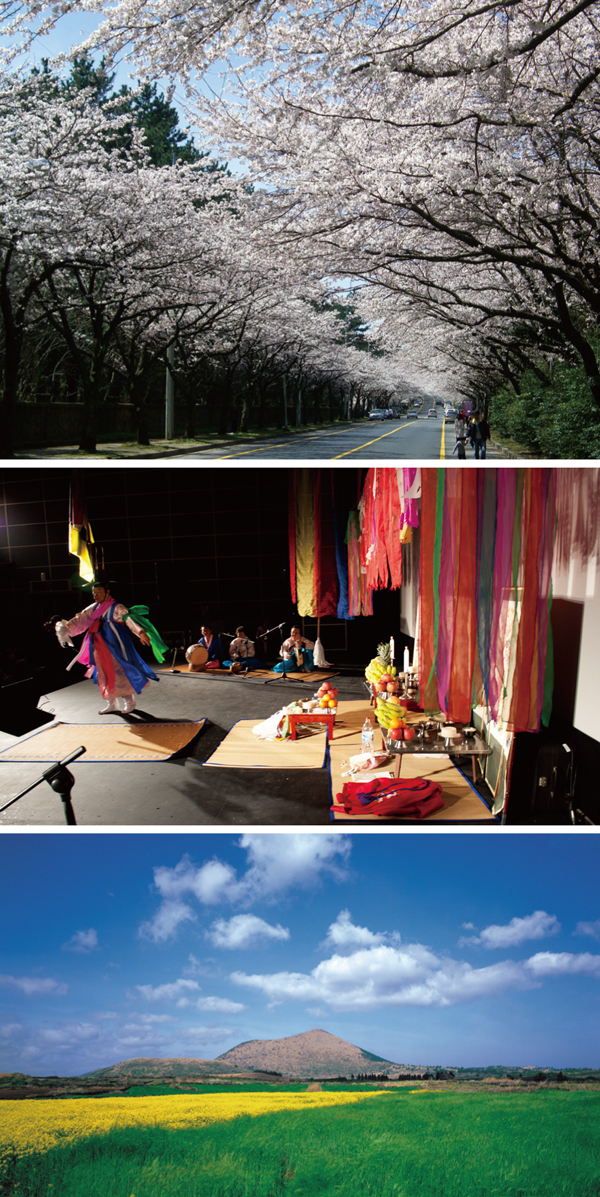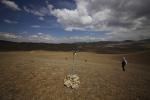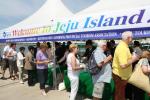|
| |
 |
|
| ▲ Top, cherry blossoms at Jeju National University. Photo by Kim Gyong Ho. Center, a Youngdeung gut ceremony. Photo by Yang Ho Geun. Above, a vista of yuchae flowers. Photo courtesy Jeju Special Self-Governing Province |
Only on the top of Mt. Halla, like a hat, white snow remains. Mt. Halla is the highest mountain (1,950 m) in South Korea and it’s a mother to all Jeju people.
With spring approaching, Jeju citizens are busy. They believe that Youngdeung, god of the wind and sea, stays on the island for about 10 days in February of the lunar calendar. Youngdeung comes to Jeju on Feb. 1 and sows seeds of shellfish and seaweed. Then she leaves before Feb. 15 of the lunar calendar. Fishermen stop fishing during this period and shamans all around Jeju ask the sea god to keep the diving women (haenyeo) safe and give them bountiful catches.
The steely northwestern wind blows and cuts like a knife during this season. It threatens the lives of fishermen and haenyeo. That’s why Jeju ancestors alerted people to the danger of the wind through the myth of Youngdeung.
The Jeju people say goodbye to Youngdeung by finishing seeding the seas. After the god leaves Jeju, the wind direction shifts easterly. The soft east wind infuses life into the haenyeo’s “sumbisory” (the sound of the sudden intake of air after resurfacing from a dive). Youngdeung’s farewell party is the shaman ritual Youngdeung gut (a UNESCO World Cultural Heritage), which announces the start of fishing once again.
After three long months of winter, the first sign of spring finally arrives on South Korea’s southern island in March.
Jeju is a rich repository of plants. In March, with the out-going winter flowers, the incoming spring flowers splendidly blossom. Over the fields, fragrant narcissus (daffodil) begin to wither, leaving their delicate scent, and forsythias, the herald of spring, are in full glory.
Following the forsythias, yellow yuchae flowers decorate the whole island. The harmony of seas wearing indigo silk dresses, inky black basalt from the volcanic eruptions, and deep-yellow yuchae flowers wow visitors. With yuchae flowers waving in the wind across the island in April, cherry blossoms bloom and the inside of the flowers turn pink.
However, spring doesn’t come all at once. With the exiting winter, jealous of the blooming flowers, early spring has a lingering cold. Overcoming piercing cold, camellia flowers blossom in villages and fields. Camellia flowers have scarlet petals and bright yellow stamens.
Camellia flowers recall flames. In March, they light a fire on snow-covered dark-green leaves.
That’s why camellia flowers have another name, “The Korean Fire.”
| Festivals in March and April |
|
• The 21st Jeju Cherry Blossom Festival (April 6 ~ 8, Jeju City)
The 21st Jeju Cherry Blossom Festival, the representative tourism spring event in Jeju, will be held for three days from April 6 to 8 in Jeju City.
The Jeju indigenous cherry blossom has big flowers. You can see gorgeous cherry blossoms everywhere in Jeju. They come into full bloom for only a couple of days and by the end of March to the beginning of April the trees are bare of flowers. But halfway up Mt. Halla, you can enjoy cherry blossoms until the middle of April.
In April, a soft breeze gently rustles the big blooms, and the pink flower petals float about in the wind. Come and enjoy this romantic island.
• The 4th Udo Conch Festival (April 12 ~ 14, Udo island)
• The 30th Jeju Yuchae Flower Festival (April 20 ~ 29, Gasi-ri, Seogwipo City)
• The Gapado Green Barley Festival (April 21 ~ May 20)
|
Info
Free Interpretation Hotline 1588-5644 (Press 1 for English, 2 for Japanese, 3 for Chinese)
Jeju Tourism Organization (www.ijto.or.kr) 064-740-6000
Korea Tourism Organization (www.visitkorea.or.kr) 02-1330
Jeju Special Self-Governing Province Tourism Association (www.hijeju.or.kr) 064-742-8861
Police 112
Jeju National University Hospital (Jeju City) 064-717-1114 (Press 1)
Seogwipo Medical Center 064-730-3106 (English operator available)
Jeju International Airport 064-742-8866
Jeju Port 064-758-7181
Jeju Welcome Center 064-740-6000~2
Jeju Local Bus Terminal 064-728-3920
Tapdong (Jeju City) 064-728-3919
Seogwipo City 064-732-1330
Hallasan National Park 064-742-3084
Jungmun Tourist Resort 064-739-1330
Jungbang/Cheonjeyeon Falls (Seogwipo City) 064-732-1393
(Translated by Yang Young Jae)
|




















